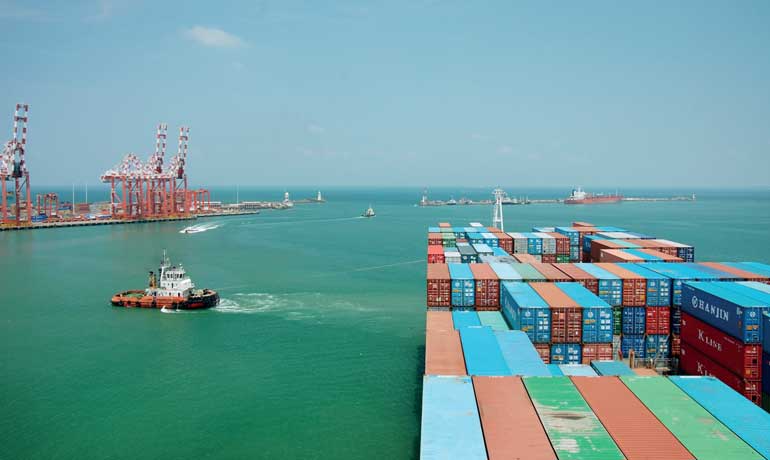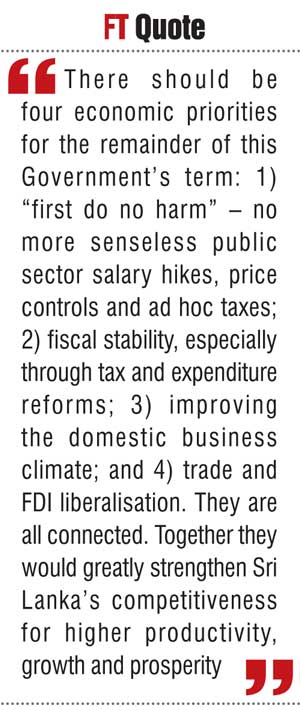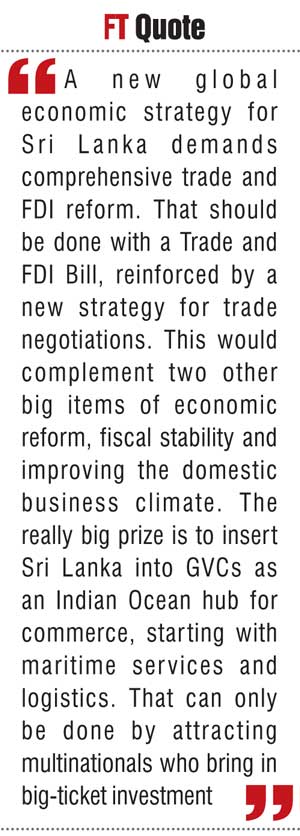Monday Dec 15, 2025
Monday Dec 15, 2025
Wednesday, 24 August 2016 00:10 - - {{hitsCtrl.values.hits}}

If the outlined measures are implemented, two prominent sectors will be opened up to international competition: shipping and tea
Sri Lanka desperately needs a new global economic strategy as part of a broader strategy for national renewal. It needs a decisive shift to markets and globalisation. A prospering, globalised market economy is the sturdiest foundation for a genuinely open society  – for constitutional liberalism, the rule of law, ethnic peace and balanced international relations. Without it, all else fails. It has to be among the Government’s top priorities. The good news is that Sri Lanka has its most golden opportunity to achieve its long-advertised potential since the victory of the UNP in June 1977.
– for constitutional liberalism, the rule of law, ethnic peace and balanced international relations. Without it, all else fails. It has to be among the Government’s top priorities. The good news is that Sri Lanka has its most golden opportunity to achieve its long-advertised potential since the victory of the UNP in June 1977.
But no economic reforms have materialised since the change of government last year. As I argued in my last Daily FT column, there should be four economic priorities for the remainder of this Government’s term: 1) “first do no harm” – no more senseless public sector salary hikes, price controls and ad hoc taxes; 2) fiscal stability, especially through tax and expenditure reforms; 3) improving the domestic business climate; and 4) trade and FDI liberalisation. They are all connected. Together they would greatly strengthen Sri Lanka’s competitiveness for higher productivity, growth and prosperity. Here I focus on the last component – a new trade policy.
Reform strategy
The overall objective should be to make Sri Lanka the most open, globalised and competitive economy in South Asia. It should be integrated into GVCs, and be an Indian Ocean hub for trade, investment and foreign talent. The trade-to-GDP ratio should at least double to over 100%. It would mean at least a tripling of export volumes. Given the connection between exports and imports, especially in GVCs, imports would rise correspondingly. That should be welcomed, not disparaged.
The export market would be more diversified. The USA and EU would remain the two key export markets, but India should be a much bigger export market, especially the four states of South India with a population of 300 million. Southeast Asia and the Far East, including China, should also be bigger export markets. The FDI-to-GDP ratio should at least double to 4-5%. Sri Lanka should get about $ 5 billion in inward investment annually. Finally, Sri Lanka should occupy GVC niches in agro-processing, manufacturing and – above all – in services.
The Government needs to get the ball rolling with a combined Trade and FDI Bill. It should contain the following:
Trade
Protective para-tariffs (notably the Port and Airport Development Levy and the Commodity Export Subsidy Scheme) should be abolished immediately and a legal commitment made not to impose new additional taxes that target imports.
Domestic equivalent taxes (that apply to imports as well as domestically produced goods) should be harmonised into a single tax and gradually abolished. This should apply to the Nation Building Tax and the Special Commodity Levy. This can be done in a separate tax reform package to simplify the tax code. The latter should be based on a small number of direct and consumption-based (VAT) tax instruments, not a paraphernalia of additional taxes.
The import tariff structure needs to be simplified radically. All specific duties should be converted into ad valorem MFN tariffs. Even then, there is too much tariff dispersion, with different tariffs on raw materials, semi-processed and finished goods. And the average nominal tariff is too high. The present three-band tariff structure (7.5, 15 and 25%) should be converted into a single tariff of 5% on industrial goods, to be phased in over five years. All other industrial goods should enter duty-free. This is what Chile did, with spectacular results. Why a modest uniform tariff? First, it is the best way of removing distortions, including corruption, arising from different tariffs on different products and at different stages of production. It has the cardinal virtue of simplicity and predictability. And second, East Asian trade-weighted import tariffs average 5% or less – which is where Sri Lanka should be.
Remaining non-tariff barriers on manufactured imports, starting with quotas and licensing arrangements, should be identified and removed as soon as possible.
Given political sensitivities, agricultural products would continue to be protected at higher levels. But the Government should start the process of converting non-tariff barriers, especially import quotas, and para-tariffs into ad valorem MFN tariffs. These can then be reduced when the time is right.
Exports should face no restrictions except on narrow national-security grounds. All export duties, including cesses on raw materials (such as tea, rubber, cashew and coconut products) should be abolished immediately.
The obvious objection to tariff-slashing is that the Government would lose much-needed revenue. Customs revenue accounts for about 40% of total Government revenue and 55% of national tax revenue. That is why tariff cuts should be accompanied by comprehensive tax reform, so that more revenue is raised from non-discriminatory domestic taxes, including a simple consumption tax. Furthermore, evidence from other countries shows that revenue loss is minimised because simple, low tariffs increase trade volumes and provide the incentive for previously illicit trade to become licit. In many instances, the effect is to increase, not decrease, revenues. Many other countries – in East Asia, Eastern Europe and Latin America – have successfully combined reduction of trade taxes and simplification of domestic taxes – and increased tax revenue in the process.
Customs administration needs to be simplified radically to reduce paperwork, delays at the border and corruption. Studies show these trade costs are higher than tariffs. An IPS study shows that corruption can add up to 50% of trade costs. “Automation” and “automaticity” should be the watchwords. All possible customs procedures should be put online, with more automatic approval procedures. Where checking is required, there should be tight deadlines for inspection and approval. All trade-related rules and regulations should be put online. Sri Lanka Customs should have a single, easily accessible enquiry point for traders. Trade documentation and signature requirements should be reduced to speed up goods clearance. Pre-arrival processing should have much greater product coverage. An independent review and appeals procedure should be established. Critically, Sri Lanka needs an automated Single Window to connect over 30 trade-related agencies. The import process is yet to be fully automated; only a few Government agencies are linked to Sri Lanka Customs’ automated system. All these measures would speed up goods clearance and reduce corruption.
 FDI
FDI
Sri Lanka has a fairly liberal regime on inward investment by developing-country standards. Full foreign ownership and non-discriminatory treatment are allowed in many sectors. But the Government should go further. All sectors should be fully open – on an automatic basis, without political and bureaucratic discretion – except for a short negative list.
The 40% equity limit on foreign shipping agencies should be removed. Full foreign ownership of shipping agencies – not just majority equity – should be allowed as an automatic right. The same conditions should apply to foreign freight forwarders. At present they are allowed 75% equity ownership providing they invest USD 10 million. This stipulation should be removed.
That leaves the question of tax incentives and the role of the BOI. Tax holidays have dominated investment policy since the economy was opened up in the late 1970s. The results have disappointed. Indeed, tax incentives have probably done more harm than good. They have been highly discretionary – a boon for corrupt politicians, officials and shady businessmen. The removal of tax incentives as part of the IMF’s EFF package is welcome. The BOI needs to be transformed from a politicised, overstaffed and corrupt tax-concession agency into a genuine one-stop-shop for foreign investors – a statutory agency that advertises Sri Lanka as an investment destination abroad, and deals with paperwork and approvals so that the investor’s path to operating a local business is smooth and seamless. That is the right lesson to learn from Singapore’s Economic Development Board, considered the paragon of investment agencies.
Sectors: Shipping and Tea
If the above measures were implemented, two prominent sectors would be opened up to international competition: shipping and tea.
The removal of the equity limit on foreign shippers would allow Maersk, Hanjin, Evergreen and other shipping lines to establish a Colombo hub for combined shipping and port-container operations. They do not do so at present because they are forced into joint-venture partnerships with local shipping agents. Maersk, for instance, might move its South Asia hub from Mumbai to Colombo – providing it has full control of its operation. That could create up to 3,000 jobs. Other international shipping lines would follow. Then the international freight-forwarders would come in. This would be the beginning and the core of a new Colombo logistics hub, halfway between the logistics hubs of Singapore and Dubai. But to get there the Government will have to overcome the opposition of a local cartel of shipping agencies.
Unimpeded openness to imports and inward investment should include tea. That would open the market to blending operations in Sri Lanka, bringing in potentially large investments and creating new jobs. This should be welcomed. But to get there the Government will have to overcome the opposition of Dilmah and others. Their argument that local blending will contaminate the Ceylon Tea brand is dubious. A bigger market, including blending, will allow for product differentiation – to cater for mass consumer markets of blended teas, and higher-price niche markets for single-country and single-estate teas.
Trade Negotiations and Trade Agreements
All measures recommended above should be implemented unilaterally, not, in the first instance, through trade negotiations. They should proceed regardless of what other countries do. I call this the Nike strategy: “Just Do It!” This will benefit Sri Lanka by signalling it is wide open for business. So why wait for cumbersome, long-drawn-out international negotiations where bargaining chips are exchanged? Sri Lanka will lose precious time and benefits if it delays liberalisation in order to extract concessions from negotiating partners. That would be a classic case of shooting oneself in the foot. East Asian countries did the bulk of their trade and FDI liberalisation unilaterally, not through the WTO and free trade agreements (FTAs). That is how they inserted themselves into GVCs. Sri Lanka should be no different. This is why a Trade and FDI Bill should come first.
International trade agreements, however, can be a helpful auxiliary to unilateral liberalisation. If done well, they lock in and extend domestic reforms, as well as open export markets. But they should never be seen as a substitute for unilateral reforms. So what should be Sri Lanka’s trade-negotiations strategy? It should be ambitious but realistic. Let’s look first at FTAs.
India: The Government should aim to complete the Indo-Lanka Economic and Technical Cooperation Agreement (ECTA) as soon as possible, and be ambitious about market-opening on both sides. That should include non-tariff barriers that impede access, particularly to the Indian market. But India is generally protectionist, and domestic opposition is lowering the Sri Lankan Government’s ambition as well. Hence ECTA will inevitably be partial, with lots of exemptions and loopholes. Like other Indian FTAs, it will be “trade-light” by international standards.
China: The Government should complete the China-Lanka FTA. But this will be trade-light, like China’s other FTAs.
Singapore: The Government should proceed with an ambitious FTA with Singapore. It should go wider and deeper than the FTAs with India and China. This will be politically easier to do: Singapore has something close to free trade already; and its exporters pose less of a competitive threat to Sri Lankan producers than Chinese and Indian exporters. Not least, an FTA with Singapore would be a training ground for more ambitious FTAs with the USA and EU.
USA and TPP: The Government should aim for an FTA with the USA. This should be its top priority for trade negotiations. Why? Because the USA is Sri Lanka’s second biggest export market; it is and will remain the most innovative economy in the world; it is home to the world’s best multinationals who can integrate Sri Lanka into GVCs, particularly in services; and, geopolitically, it would cement an alliance with the world’s only superpower and “balancing power” in Asia, which is also a civilised liberal democracy. Also, US FTAs, unlike Asian FTAs, are serious: they are comprehensive and deep. They demand substantial liberalisation in goods, services, investment and public procurement, underpinned by strong disciplines (also on product standards, intellectual property and subsidies), and enforced by strong dispute-settlement procedures. Unlike FTAs with China, India and other Asian partners, an FTA with the USA would spur domestic market reforms and expand competition in the economy, in addition to gaining extra access to  the US market.
the US market.
However, there is no need to negotiate a bilateral FTA with the USA. It and ten other Asia-Pacific countries have negotiated the Trans-Pacific Partnership (TPP), covering 40% of the world economy and a third of international trade. This is the most ambitious trade deal since the Uruguay Round Agreements over twenty years ago. Sri Lanka should consider lodging an application to join it. That would obviate bilateral FTAs with other potentially important trading partners such as Japan, Australia and Malaysia. And it would be a great signal to foreign investors: Sri Lanka would be the first South Asian country in the TPP.
The first step is to conclude a Trade and Investment Facilitation Agreement (TIFA) with the USA. But negotiating entry to the TPP – or any FTA with the USA – would be excruciating and could induce a domestic political backlash. So the ground has to be prepared carefully. A Trade and FDI Bill should come first. The TPP should only be considered a serious prospect when trade and FDI liberalisation is already underway. There is also a huge question mark over the TPP, given rising protectionist sentiment in US politics. Next year, if it looks likely that the TPP will be ratified, Sri Lanka could apply to join it. In any case, there are up to eight other countries in the queue to join the TPP. It will take some time for Sri Lanka’s application to be processed and for negotiations to conclude. That will give the Government time to prepare the way for accession with changes to domestic trade-related rules and regulations.
EU: The Government should aim for an FTA with the EU as well – going beyond the limited gains of a restoration of GSP-Plus. EU FTAs are relatively strong, though not as strong as US FTAs. The EU has a long-stalled FTA negotiation with India, so an EU-Lanka FTA could be the EU’s first in South Asia.
UK: The Government should also consider an FTA with the UK in the wake of Brexit.
Prioritisation: It is imperative the Government does not agree to FTA negotiations with all and sundry. Rather its priorities should be India, the TPP and EU. For one thing, Sri Lanka has hardly any trade-negotiating capacity. It will have to be built up virtually from scratch; and it will have more than enough on its plate with India, China, Singapore, the TPP, the EU and UK.
WTO: The Doha Round is dead. But a multilateral rules-based trading system is still important, especially for small economies like Sri Lanka. So it should not disengage from the WTO. On the contrary, it should re-engage, only this time with a different strategy. It should break ranks with India and other Third World foot draggers, and join forces with the OECD and emerging-market countries (like Chile, Colombia, Costa Rica, Singapore and Hong Kong) that favour liberalisation and pro-market rules. In this spirit, Sri Lanka should join the Information Technology Agreement, which has zero tariffs on IT goods, as well as the plurilateral TISA negotiations to liberalise trade in services. This should be done immediately.
Process issues
The proposed new Agency for International Trade in the Ministry of International Trade and Development Strategies should coordinate both a Trade and FDI Bill and a new trade-negotiations strategy. But the new agency has to be built up from scratch. And there is turf conflict with the Department of Commerce, which houses what little trade-policy expertise Sri Lanka has. This will have to be resolved if any trade-policy strategy is not to fall apart – the sooner the better. It may be best to peel off the international trade sections of the DOC and fold them into the Trade Agency.
Conclusion
A new global economic strategy for Sri Lanka demands comprehensive trade and FDI reform. That should be done with a Trade and FDI Bill, reinforced by a new strategy for trade negotiations. This would complement two other big items of economic reform, fiscal stability and improving the domestic business climate. The really big prize is to insert Sri Lanka into GVCs as an Indian Ocean hub for commerce, starting with maritime services and logistics. That can only be done by attracting multinationals who bring in big-ticket investment. They favour countries with open borders to imports, exports and investment. But they also want strong intellectual-property protection; transparent and competitive public-procurement regulations; ready availability of land; good infrastructure; a flexible labour market; and uncomplicated tax regulations, licensing procedures and work permits for foreign nationals. In short, they want openness combined with simple, transparent and predictable regulations. Some of these items, especially on land and labour laws, will require separate reforms that are even more sensitive than trade and FDI liberalisation. But trade and FDI reforms are the right place to start.
(The author is Chairman of the Institute of Policy Studies, Sri Lanka, and Associate Professor, Lee Kuan Yew School of Public Policy, National University of Singapore.)